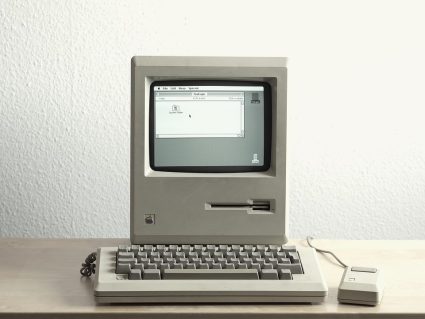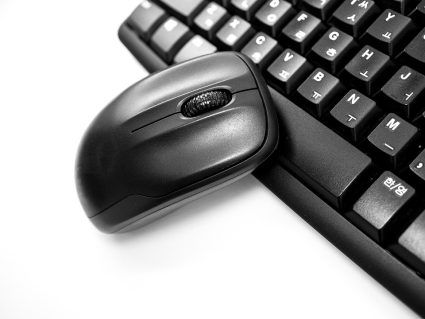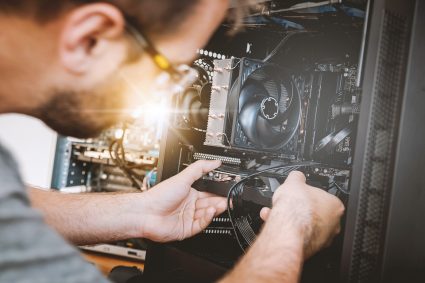
Laptops are a key part of our everyday lives. They provide us with the means to stay connected to the world and stay productive while on the go. From the first portable computers to the sleek, powerful laptops of today, there is no denying that laptops have changed the way we work and play. In this article, we’ll take a look at the evolution of laptops, from their humble beginnings to their current state of the art.
Content of the page
The Evolution of Laptops
From the First Portable Computers to Modern Laptops

The history of laptops is a long and fascinating one. It all began in 1981, when the first portable computers were released. These machines, called “luggables”, were bulky, expensive and had limited capabilities. However, they paved the way for the modern laptops we know and love today.
Over the years, laptop technology has advanced considerably. The introduction of the Intel 386 processor in 1985 made laptops faster and more powerful. The introduction of the CD-ROM drive in 1988 made it possible to store large amounts of data on a laptop. In 1990, the first laptop with a color display was released.
The introduction of the USB port in 1995 made it easier to connect peripherals to a laptop. In the late 1990s, laptops became more powerful and more affordable. By the 2000s, laptops had become commonplace, with many people using them for work and play.
Today, laptops are more powerful than ever. They come in various shapes and sizes, and can be customized to suit the user’s needs. They are also more affordable than ever, making them accessible to more people.
How Laptops Have Changed the Way We Work and Play

Laptops have revolutionized the way we work and play. They are incredibly versatile and can be used for a variety of tasks. From writing documents to checking email, laptops make it possible to stay productive while on the go.
Laptops also make it possible to stay connected to the world. With the introduction of the Internet, we have access to a wealth of information and entertainment. From streaming movies to playing online games, laptops make it possible to stay entertained while on the go.
In addition, laptops have changed the way we communicate. With the introduction of video conferencing, we can stay connected with our friends and family no matter where we are.
Finally, laptops have changed the way we learn. With the introduction of e-learning, students can access educational materials from anywhere in the world.
In conclusion, laptops have revolutionized the way we work and play. They are versatile, powerful, and affordable, making them accessible to more people. With the introduction of the Internet, they have become essential tools for connecting with the world.
Key Components of a Laptop
When it comes to buying a laptop, it’s important to understand the different components that make up a laptop and how they interact with one another. In this section, we’ll cover the main components of a laptop, including the processor, display, keyboard and touchpad, and battery life.
The Processor: Understanding the Brain of Your Laptop
The processor, or CPU, is the “brain” of your laptop, and it’s responsible for carrying out the instructions you give it. When choosing the right processor for your laptop, the two main factors to consider are the speed of the processor and the type of processor.
The speed of the processor is measured in gigahertz (GHz). Generally, the higher the GHz, the faster the processor will be, so if you’re looking for a laptop that can handle more intensive tasks, it’s best to look for one with a higher GHz rating.
The type of processor is also important to consider. Most laptops today use one of two types of processors: Intel or AMD. Intel processors are generally faster than AMD processors and are more suited to high-performance tasks, such as gaming and video editing. AMD processors are typically better suited for everyday tasks, such as web browsing and word processing.
The Display: Choosing the Right Screen for Your Needs
The display of your laptop is one of the most important components to consider when buying a laptop. The size and resolution of the display will have a direct impact on the overall performance of your laptop, as well as how comfortable you are when using it.
When choosing the right display for your laptop, the two main factors to consider are the size of the display and the resolution. The size of the display is measured in inches, and the resolution is measured in pixels. Generally, the larger the size of the display, the higher the resolution will be.
The resolution is important to consider as it will determine how sharp and clear images and text will appear on the screen. Higher resolutions will generally result in sharper and clearer images, while lower resolutions will be less sharp and clear.
The Keyboard and Touchpad: Tips for Maximum Comfort and Productivity

The keyboard and touchpad are the two main input devices used to interact with your laptop. The keyboard is used for typing, while the touchpad is used for pointing and clicking. When choosing the right keyboard and touchpad for your laptop, there are a few factors to consider.
First, consider the size and layout of the keyboard. Most laptops come with full-size keyboards, but there are some that come with smaller, compact keyboards. It’s important to choose a keyboard that fits your hands and typing style, as this will make typing more comfortable and efficient.
Second, consider the type of touchpad. Most laptops come with a standard touchpad, but there are some that come with an “ergonomic” touchpad. An ergonomic touchpad is designed to be more comfortable to use and can help reduce wrist strain and fatigue.
Battery Life: Understanding Your Laptop’s Power Needs
Battery life is an important factor to consider when buying a laptop, as it will determine how long you can use your laptop without needing to recharge. The amount of battery life a laptop has is determined by the size of the battery and the power efficiency of the laptop.
When it comes to the battery size, it’s important to choose a laptop with a large battery, as this will give you more hours of use on a single charge. Additionally, it’s important to choose a laptop with good power efficiency, as this will help to extend the battery life.
In conclusion, understanding the key components of a laptop is important when buying a laptop. It’s important to consider the processor, display, keyboard and touchpad, and battery life to ensure that you get the right laptop for your needs.
Types of Laptops
When it comes to laptops, there are many different types to choose from. Each type has its own unique features and benefits, so it’s important to understand the differences before making a purchase. This article will provide an overview of the different types of laptops available, including ultrabooks, gaming laptops, 2-in-1 laptops, and Chromebooks.
Ultrabooks: Sleek and Portable Performance Machines
Ultrabooks are the thinnest and lightest laptops available. They are designed to be extremely portable, while still providing powerful performance. Ultrabooks are typically made out of lightweight materials like aluminum or magnesium, and feature powerful Intel Core processors. They also have high-resolution displays and long battery life, making them ideal for those who need a laptop for work or school.
Gaming Laptops: High-Performance Machines for Gamers
If you’re a serious gamer, then a gaming laptop is the way to go. Gaming laptops are designed to deliver high performance and smooth gaming experiences. They feature powerful processors, dedicated graphics cards, and high-resolution displays. They also come with a range of other features, such as backlit keyboards, anti-ghosting technology, and surround sound support.
2-in-1 Laptops: The Best of Both Worlds
2-in-1 laptops are a great option for those who want the flexibility of using a laptop as well as a tablet. These devices are designed to be both a laptop and a tablet, allowing you to switch between the two modes with ease. 2-in-1 laptops feature touchscreens, long battery life, and powerful processors, making them a great choice for those who need a versatile device for work or school.
Chromebooks: Affordable and Efficient Web Browsing Machines
Chromebooks are a great option for those who primarily use their laptop for web browsing. They are affordable, lightweight, and feature long battery life. Chromebooks are powered by Google’s Chrome OS, which is designed to be fast and efficient. Chromebooks also come with a range of other features, such as built-in virus protection and secure online storage.
| Type of Laptop | Pros | Cons |
|---|---|---|
| Ultrabook | Lightweight and portable, long battery life, fast performance | Expensive, limited upgrade options, may have fewer ports |
| Gaming Laptop | Powerful performance for gaming, high-quality graphics, large storage capacity | Heavy and bulky, short battery life, expensive |
| Chromebook | Affordable, simple and easy to use, fast boot times, long battery life | Limited offline capabilities, limited software availability, may not be suitable for advanced tasks or applications |
| Business Laptop | Durable and reliable, long battery life, security features, suited for multitasking | Can be heavy, less stylish design, expensive |
| 2-in-1 Laptop/Tablet | Versatile, can be used as a laptop or tablet, touchscreen interface, lightweight and portable | Limited processing power compared to traditional laptops, can be expensive |
| Traditional Laptop | Wide range of configurations, keyboard and touchpad interface, reliable performance | Can be heavy, limited mobility, may have shorter battery life compared to ultrabooks |
Operating Systems for Laptops
When it comes to choosing a laptop, one of the biggest considerations is the operating system. The operating system is the main software that runs on your computer and is responsible for managing its resources, as well as providing a platform for other applications to run on. Different operating systems provide different features, so it’s important to choose one that fits your needs.
Windows: The Most Popular OS for Laptops
Windows is by far the most popular operating system for laptops. It’s been around for over 30 years, and it’s been constantly improved and updated. Windows is designed to be user-friendly and easy to use, and it has a large library of applications that can be used to do almost anything. It also supports a wide range of hardware, so it can run on almost any laptop.
Windows is also the most configurable operating system, allowing you to customize almost every aspect of how it looks and works. This makes it a great choice for those who want to customize their laptop to suit their needs.
MacOS: The Power and Simplicity of Apple Laptops
MacOS is the operating system that is used on Apple laptops. It has been around since 1984, and it’s been improved and updated over the years. MacOS is highly optimized for Apple’s hardware, so it runs very smoothly and efficiently on their laptops. It also has a large library of applications that can be used to do almost anything.
MacOS is known for its simplicity and ease of use. It has a user-friendly interface, and it’s designed to be intuitive and easy to use. It also has a number of built-in applications that make it easy to get started on your laptop.
Linux: The Open-Source Alternative
Linux is an open-source operating system, meaning it is free to use and modify. It has been around since 1991, and it has become increasingly popular over the years. Linux is designed to be lightweight and efficient, so it runs very well on most laptops. It also has a large library of applications that can be used to do almost anything.
Linux is also highly customizable, allowing you to customize almost every aspect of how it looks and works. This makes it a great choice for those who want to customize their laptop to suit their needs.
Buying a Laptop
When it comes to buying a laptop, there are a few things to consider. Laptop computers come in a variety of sizes, types, and prices, and it is important to know what you’re looking for before heading to the store. Before making a purchase, make sure you know the answers to these questions:
- How much are you willing to spend?
- What type of laptop do you need?
- What size screen do you need?
- What type of processor do you need?
- What type of graphics card do you need?
- How much RAM do you need?
- What type of hard drive do you need?
- What type of operating system do you need?
- What type of battery life do you need?
- What type of wireless connection do you need?
Once you have answered these questions, you can start looking for a laptop that meets your needs.
What to Look for When Buying a Laptop
When shopping for a laptop, there are a few key features to look for. It is important to look for a laptop that has a good processor, plenty of RAM, a good graphics card, and a good hard drive.
Here are some other important features to consider when buying a laptop:
- Display: Look for a laptop with a good display, one that is bright and clear. This will make it easier to use the laptop in different lighting conditions.
- Battery life: Make sure to check the battery life of the laptop you are considering. Look for one with a long battery life so you don’t have to worry about charging it often.
- Weight: If you plan on carrying your laptop around a lot, make sure to check the weight of the laptop. Look for one that is lightweight and easy to transport.
- Connectivity: Make sure the laptop has all the ports and connections you need. Look for one with a good wireless connection and one that supports the latest technologies.
- Durability: Check the durability of the laptop you are considering. Look for one that is designed to withstand the wear and tear of everyday use.
Top Brands of Laptops
When it comes to buying a laptop, there are a few top brands that are worth considering. These brands have been around for a long time and have a good reputation for quality and reliability. Some of the top laptop brands include:
- Apple: Apple is one of the most popular laptop brands. They offer laptops with great performance, good battery life, and a great design.
- Dell: Dell is another popular laptop brand. They offer laptops with great performance, good battery life, and a great design.
- HP: HP is another popular laptop brand. They offer laptops with great performance, good battery life, and a great design.
- Lenovo: Lenovo is another popular laptop brand. They offer laptops with great performance, good battery life, and a great design.
- Acer: Acer is another popular laptop brand. They offer laptops with great performance, good battery life, and a great design.
When looking for a laptop, it is important to research the different brands and find one that meets your needs.
Comparing Laptops: Which One Is Right for You?
Once you have narrowed down your search to a few top brands, it is time to compare laptops and find the right one for you. It is important to compare laptops on a few key features. These include:
- Price: Price is an important factor when comparing laptops. Look for a laptop that is within your budget.
- Performance: Performance is another important factor when comparing laptops. Look for one with a good processor, plenty of RAM, and a good graphics card.
- Battery life: Battery life is another important factor when comparing laptops. Look for one with a good battery life so you don’t have to worry about charging it often.
- Weight: If you plan on carrying your laptop around a lot, make sure to check the weight. Look for one that is lightweight and easy to transport.
- Connectivity: Make sure the laptop has all the ports and connections you need. Look for one with a good wireless connection and one that supports the latest technologies.
- Durability: Check the durability of the laptop you are considering. Look for one that is designed to withstand the wear and tear of everyday use.
Once you have compared the laptops on these features, you can make an informed decision about which one is right for you.
Caring for Your Laptop
Caring for your laptop computer is essential to maintaining its performance and longevity. To keep your laptop working at its best, it is important to keep it clean, protect it from viruses and malware, and back up your data regularly. This guide provides tips and advice on how to care for your laptop and keep it running smoothly.
Tips for Maintaining Your Laptop’s Performance
Maintaining your laptop’s performance requires a few simple steps. First, make sure that you keep your laptop powered up and running. This means keeping it plugged in and fully charged when not in use. It’s also important to keep your laptop clean and free of dust and debris. Regularly cleaning your laptop’s internal components can help to prevent overheating and keep your laptop running at optimal levels.
It’s also important to keep your laptop’s software updated. Keeping your laptop’s operating system and other programs up-to-date will help to ensure that it runs smoothly and efficiently. Additionally, installing antivirus and anti-malware software can help to keep your laptop safe from malicious software and viruses.
How to Clean Your Laptop and Keep It in Top Condition
 Regularly cleaning your laptop is an important part of maintaining its performance. To clean your laptop, you’ll need a soft, lint-free cloth and some rubbing alcohol. Start by wiping down the outside of your laptop with the cloth. Then, spray a small amount of rubbing alcohol onto the cloth and carefully wipe down the laptop’s keyboard and touchpad. You should also use the alcohol-soaked cloth to clean the vents on the side of your laptop, as well as the fans on the bottom of the laptop.
Regularly cleaning your laptop is an important part of maintaining its performance. To clean your laptop, you’ll need a soft, lint-free cloth and some rubbing alcohol. Start by wiping down the outside of your laptop with the cloth. Then, spray a small amount of rubbing alcohol onto the cloth and carefully wipe down the laptop’s keyboard and touchpad. You should also use the alcohol-soaked cloth to clean the vents on the side of your laptop, as well as the fans on the bottom of the laptop.
Finally, use a compressed air canister to blow out any dust or debris that has collected in your laptop’s fans and vents. Once you’ve finished cleaning your laptop, make sure to dry it thoroughly with a clean, dry cloth. By regularly cleaning your laptop, you can help to keep it running at peak performance and avoid any potential damage.
Backing Up Your Data: A Guide to Laptop Data Security
Backing up your data is one of the most important steps you can take to protect your laptop from data loss. By backing up your files regularly, you can make sure that you have a copy of all of your important documents, photos, music, and videos stored safely in case of an emergency. There are several different methods for backing up your data, including online storage services, external hard drives, and cloud storage services.
When backing up your data, it’s important to use multiple storage locations to ensure that your data is safe. Additionally, you should make sure to test your backups regularly to make sure that they are working properly. By following these simple steps, you can ensure that your data is secure and that your laptop is always running smoothly.
Conclusion
Laptops are a great way to stay productive and connected while on the go. By following the tips and advice outlined in this guide, you can keep your laptop running at its best and protect it from data loss. Additionally, it’s important to keep your laptop clean and free from dust and debris, and to back up your data regularly. With proper care and maintenance, your laptop can provide you with years of reliable service.
The Future of Laptops: What’s Next?
The future of laptops is bright. With advances in technology, laptops are becoming lighter, faster, and more powerful than ever before. We can also expect to see more features, such as touchscreen displays and improved battery life, as well as a wider range of sizes and styles. With these new advances, laptops will continue to be an important part of our lives for many years to come.
